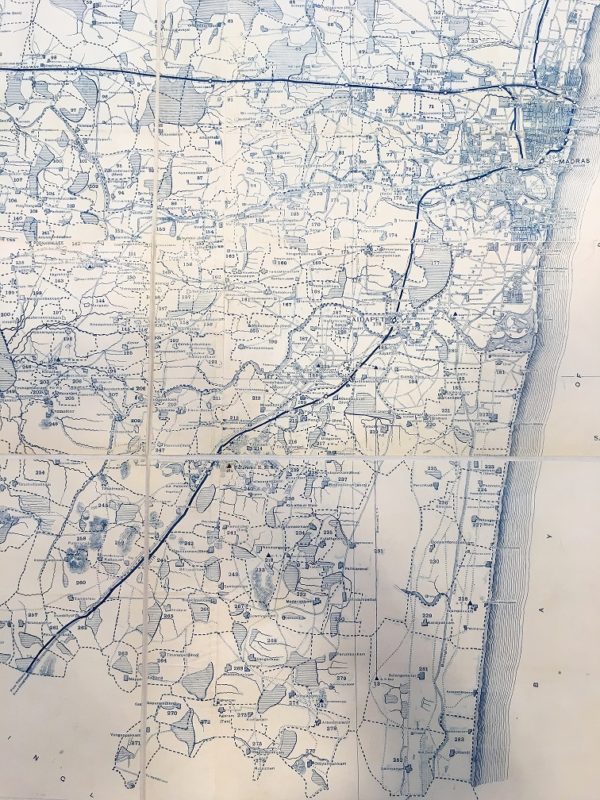Having joined the Monsoon Assemblages team in mid-August, I find myself one month in to the project and time has flown. Over the past weeks we have started the process of ‘finding the field’ and locating ourselves within the project. As most of the team have not worked in Chennai before, we have begun by getting to know the city from a distance. This has involved the usual academic activities of reading and conducting literature reviews.

Detail of ‘Map of Saidapet Taluk, Chingleput District. Madras: Survey Office, 1905’. By permission of the British Library. Photo: Beth Cullen
In addition to academic sources, we have mined the ‘grey literature’, as well as English language newspapers, blogs and social media, all of which give a rich insight into the life of the city. According to some it is ‘not a city you will fall in love with at first sight’!
Considering the monsoonal theme of our research, water has been something of a focal point. Rain is probably the element most commonly associated with the monsoon weather system. The floods of 2015 are a recurring and prominent topic in newspaper articles, with much discussion about who or what was responsible for the disaster. In the course of our investigations, certain infrastructural characters have emerged from Chennai’s watery domain including disappeared water tanks, the Buckingham canal, storm drainage systems, the Pallikaranai marsh, an IT corridor, and the Perungudi dumpsite.
Although the connections may not be immediately obvious, these features of the urban landscape relate to the various ways in which ‘the monsoon’ is experienced and managed (or not managed) by ‘the city’. To gain an understanding of the contextual dynamics and complex interconnections we have been getting to know these characters by tracing their histories through travel literature, colonial documents and policy reports, locating them on historical maps, discovering how they have been represented in photographs and drawings, as well as in academic papers written by natural scientists, engineers, historians and anthropologists.
As an anthropologist, my instinct has been to try and familiarise myself with the region by starting the fieldwork process ‘at home’. So as well as reading (and frequent trips to various libraries), there have been more sensory forms of engagement: eating dosas in South Indian restaurants and starting to learn some basics of the Tamil language with a former resident of Chennai.
Working with two architecturally trained urbanists has ensured a strong focus on the spatial elements of the city. Although we cannot physically traverse the space we have embarked on remote explorations of the terrain via google maps, satellite imagery, geological and hydrological maps. Film footage has provided a useful way of sensing the city and anticipating monsoonal conditions. The video ‘Copper House’ by Studio Mumbai captures the sounds and textures of the rain as well as contrasts between the seasons. ‘Shunted to the Margins’, a participatory video produced by relocated slum dwellers, and drone footage of the high-rise, high-tech infrastructure of the IT corridor (our initial field site) offer strikingly different views of the city and provide a sense of the social, economic and political dynamics.
Over the past month we have made valuable connections with others working on related topics. As well as starting to organise guest speakers for the MONASS seminar series, we were invited to attend 3×3 Bangladesh Design, an exhibition of drawings, photographs and presentations of design projects from emerging design studios in Bangladesh. It was particularly interesting to see the ways in which these projects have utilised participatory design approaches, including participatory video.
As the University term begins we are planning our first visit to Chennai in December, with students from the Master of Architecture programme. It will be fascinating to encounter the city for ourselves, after exploring it from afar, and to relate the knowledge we are gaining to our own lived experience.
